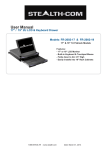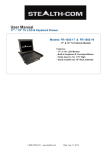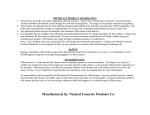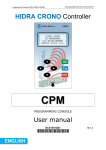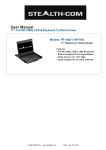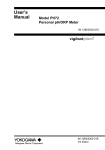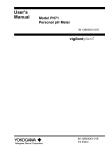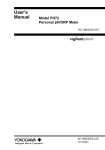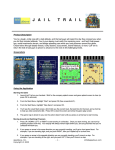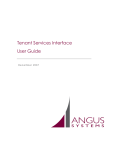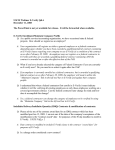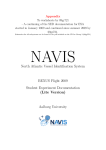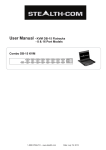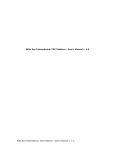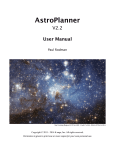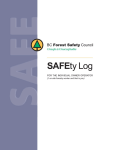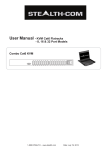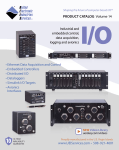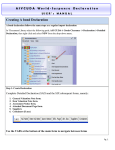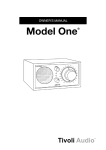Download Port User Manual and Information 1st Edition Container Terminal
Transcript
Port User Manual and Information 1st Edition Container Terminal Truck Driver’s Edition Issued: November, 2013 0 Nassau Container Port User Manual Container Terminal Truck Driver’s Edition Table of Contents Section 1. 2. 3. 4. 5. 6. 7. 8. 9. 10. 11. 12. Welcome & Overview Port Contact List Safety In The Port ISPS Regulations & Requirements NCP Identification & Entry Requirements Port Rules & Regulations & Responsibilities Port Layout NCP Gate Transaction Process Security In The Port NCP Administration Glossary of Terms Signature Page - Page 2 3 4 8 11 15 23 24 26 29 30 33 [Please Note: The Content of this Manual may be updated by APD Limited from time to time without notice, Port users are advised to always seek to verify from APD’s administration offices whether this Manual has received any updates – you may also log on to our website at www.nassaucontainerport.com for information.] 1 Section 1. Welcome & Overview. Welcome to the Nassau Container Port! The long held dream of moving commercial shipping activities from Bay Street to a modern, state of the art seaport at Arawak Cay has been realized, after a tremendous amount of hard work by many people. The Nassau Container Port at Arawak Cay has been designed and built to provide world class shipping services to Nassau and the Bahamas, to support growth and economic strength for all Bahamians, for years to come. Because the Nassau Container Port (NCP) can be a very busy place, it is important that we have clear, easy to understand rules for all those using the port, to ensure safety, and avoid confusion, traffic congestion and delays. International rules for security and safety have also been implemented, and modern computer systems have been installed to ensure efficient operations throughout the port. Bahamas Customs is located at NCP, and all Bahamas Customs rules, regulations and procedures are supported and enforced at NCP. A large part of the work and activity at NCP involves truckers hauling containers into and away from the port. It is extremely important that all truck drivers entering the port know, understand and follow the NCP rules and guidelines, to ensure safe, trouble-free, and timely operations at the port. Truckers must be responsible for their loads and this responsibility involves (but is not limited to) ensuring that the loads are properly secured, locked or strapped. Please take the time necessary to familiarize yourself with everything included in this guide. Make note of any questions 2 or things you’re not clear on, and call the NCP Helpline to get the answers you need. We thank you the users of the Port for complying with these rules and your valuable contributions. Let’s all do our part to make NCP a safe workplace. Section 2. NCP Contacts & Telephone Numbers NCP Port Security (24 Hours) 242-601-5039 NCP Administration & Help Line (main number) 242-323-7064 NCP Operations 242-323-7064 NCP (After Hours) Help Line 242-601-5039 or 242-601-5037 Government Services: Bahamas Customs – 242-325-6550 Department of Environmental Health Services 242-322-8037, 242-601-5047, or 242-601-5044 Ministry of Agriculture 242-325-7502 or 242-325-7413 Royal Bahamas Police Force (Arawak Cay) 242-323-8079 Carriers: Betty K - (NCP) 242-322-8983, (Office) 242-322-2142 Duke of Top Sail – 242-322-5460 Mailboat – 242-502-2628 MSC – 242-325-7365 Tropical Shipping – 242-397-7202 3 Section 3. Safety In The Port NCP is a busy, commercial seaport facility, where many people work, and a lot of cargo and heavy equipment are moved around. Port safety rules and procedures are designed to protect you and everyone else in the port from accidents and injury. SAFETY IS OUR HIGHEST PRIORITY AT NCP! All areas of operations within NCP may require personnel or visitors to wear safety equipment, such as hard hats or reflective vests, etc. Safety Equipment Charts must be observed. ALL SAFETY RULES MUST BE FOLLOWED AT ALL TIMES. Any Driver or visitor violating NCP Safety Rules may be escorted out of the port immediately by NCP Security staff. Repeat violations of NCP Safety Rules may result in a permanent ban from the port. Repeat breaches of the Port Safety rules may result in the following sanctions: 1. 2. 3. 4. A warning 1 Week’s suspension 1 Month’s suspension Up to expulsion from the Port A. All trucks entering NCP must meet NCP safety standards which include: 1) 1/8” or greater tread groove pattern depth on all front tires, and 1/16” on all other tires. Tread depth shall be measured at any point on a major tire groove, but not where tie bars, humps or fillets are located. 2) Truck brakes, air lines and brake lights must be functional and in good working order. 3) No leaking oil or fluids. 4) No body or mechanical parts hanging off or down underneath the truck. 5) Working horn. Note: 4 Operators are strongly advised to have a certified 5lb ABC Fire Extinguisher in the vehicle at all times. B. While in the port, all vehicles must be operated in a careful, cautious manner. The 15MPH speed limit is the MAXIMUM speed allowed within the port. C. Drivers are required to wear a Hi-Vis Safety Vest whenever exiting their trucks – NCP suggests you wear your vest at all times while within the Port. Always check for other traffic when locking chassis pins, connecting or disconnecting air lines, opening container doors, etc. Drivers must also wear rubber soled or tennis shoes – slippers or bare feet are not acceptable or allowed. D. Drivers must stay with their trucks, unless requested to leave their truck by NCP staff, or as procedurally required, i.e., Gate 3 Out. Walking in the port is not allowed, unless escorted by NCP staff, for Safety and Security reasons. E. The truck driver/trucking company is responsible for ensuring that all loaded flatracks are loaded in a safe manner, and fully secured with chains and binders, straps or steel banding. Drivers must notify NCP and the Carrier of any unsafe loads, containers or chassis. F. Some containers in NCP contain hazardous materials, and are placarded as such. Drivers should familiarize themselves with hazardous placarding standards and meanings and should behave responsibly concerning such material. 5 If you see something leaking from a container that has hazardous placards, DO NOT OPEN THE CONTAINER! There may be fumes or chemicals inside that could harm you. See rule H below. G. In the event of any accident, fire or hazardous material incident, NCP Staff must be notified IMMEDIATELY. They will use special emergency plans and training to resolve the issue quickly and safely. Promptly follow any instructions NCP Staff gives you. NCP staff will also complete a required Safety Incident Report for all such occurrences. H. NCP is a SMOKE FREE facility, for health and safety reasons. This means NO SMOKING is allowed anywhere within NCP or GFT. I. Safety Signs are posted throughout NCP to ensure your safety, as well as all those who work or visit here. It is very important that you follow the information and warnings on these signs. A sample of the kinds of Safety Signs you may see at NCP, and an explanation of their colors and meanings is included in Figure 1, on the next page. Please familiarize yourself with the signs and their meanings. 6 KNOW YOUR SAFETY SIGNS! Get to know what the symbols mean – they are provided for your safety! There are four main categories, each has a different shape and colour. EXAMPLE A complete list of the Safety signs used at NCP can be downloaded from our website at www.nassaucontainerport.com or can be collected from our administration offices. Figure 1 7 Section 4. ISPS Regulations & Requirements NCP is an international seaport facility, and is required to follow the International Ship & Port Facility Security Code (ISPS). This ISPS Code was developed and approved by the International Maritime Organization (IMO), a specialized agency of the United Nations, with 170 Member States and three Associate Members, of which The Bahamas is a part since 1976. The main objectives of the ISPS Code are: • To control access to Port facilities and vessels • To detect security threats and implement security measures • To establish roles and responsibilities concerning maritime security for governments, local administrations, ship and port industries at the national and international level • To collate and promulgate security-related information • To provide a methodology for security assessments so as to have in place plans and procedures to react to changing security levels To support achieving these objectives the ISPS Code uses certain terms and concepts, which have been included in and are part of NCP Operational Procedures. Below are a few of these terms and concepts in use at NCP. You, as an NCP port user, must be familiar with these terms and concepts, and follow all NCP rules and regulations, to enjoy NCP access privileges. Please be advised that from time to time NCP will be conducting Security drills and exercises that may create 8 temporary delays. We thank you in advance for your cooperation and understanding. A. TWIC – Transportation Worker Identification Credential. Essentially a specialized form of Identity Card for those who require access to areas inside the port security perimeter. NCP TWIC cards are issued by APD Limited. B. SECURITY – ISPS Security Levels. These levels indicate different threat levels, and different security rules that are followed based on those threat levels. In times of normal/low threat levels, yellow signs indicating that SECURITY LEVEL 1 rules are in force will be displayed at the port, and standard ISPS rules will be in force. This Facility is currently operating at SECURITY LEVEL 1 ISPS Security Level Minimum appropriate protective security measures shall be maintained at all times in accordance to the Facility Security Plan Report transportation security incidents or suspicious people, objects or activities to: PORT SECURITY 242.601-5039 When a higher threat level is declared above SECURITY LEVEL 1 NCP will display orange SECURITY LEVEL 2 signs, and stricter ISPS rules will be enforced. These rules may include closer inspection of identification, vehicles or cargo, or restricted access to certain parts of the port. 9 This Facility is currently operating at SECURITY LEVEL 2 ISPS Security Level Appropriate additional protective security measures shall be maintained for a period of time as a result of heightened risk of a transportation security incident. Report transportation security incidents or suspicious people, objects or activities to: PORT SECURITY 242.601-5039 In the event the designated authority elevates the threat level to SECURITY LEVEL 3 NCP will display the red SECURITY LEVEL 3 sign at the entrance to the NCP gate and berthand NCP will immediately implement all security rules associated with SECURITY LEVEL 3 status. These rules may include extremely close inspection of identification, persons, vehicles or cargo, along with very restricted access to, or temporary closure of the Port. This Facility is currently operating at SECURITY LEVEL 3 ISPS Security Level Further specific protective security measures shall be maintained for a limited period of time when a transportation security incident is probable or imminent, although it may not be possible to identify the specific target. Report transportation security incidents or suspicious people, objects or activities to: PORT SECURITY 242.601-5039 10 C. PFSO – Port Facility Security Officer. The person(s) responsible for the implementation, Management and Maintenance of the specific Port Facility Security Plan. D. PFSP – Port Facility Security Plan. Every ISPS Compliant facility has an approved confidential Security Plan which describes how the facility security will be operated and how the port facility will respond to the declared threat levels. Section 5. NCP Identification and Entry Requirements NCP’s Identification, entry rules and ISPS regulations have been implemented to ensure security and protection of ships, cargo, port facilities and people, from terrorism and other illegal activities. These rules are non-negotiable, and must be followed at all times. Failure to follow stated rules and regulation may result in violators being denied entry to NCP for a fixed period of time, or in the case of serious violations, permanently. A. ALL persons requesting entry to NCP, for any purpose whatsoever, MUST present valid identification in accordance with the rules set forth here. B. Proper identification MUST be presented whenever asked for by NCP staff or Security. Failure to present identification when requested will result in being escorted from the port. C. The NCP TWIC (Transportation Worker Identification Credential) is the official NCP identification credential. To 11 obtain one you must complete an application at the NCP offices in the Administration building. You will need to bring several forms of identification and certain documentation with you when you apply for your NCP TWIC card, and pay the application fee of $15.00. See the specific documents to bring below. NCP TWIC is valid for a period of 12 months, and must be renewed annually. You can pre-pay for your TWIC for a period of 3 years. However, the NCP may revoke your TWIC at any time for Port violations or if there are criminal charges or criminal investigations relative to the applicant. There will be no refund of any pre-payments made or unused. D. It is important to note that TWICs are the property of the NCP and not the individual. Drivers who lose their NCP TWIC prior to its expiry date may apply for a replacement TWIC at the Administration Building. Persons who have applied for and received a TWIC for a period of 1 year or who have pre-paid for a period of 3 years must note the following: a. A TWIC replacement is granted at the discretion of the NCP. If a first replacement is granted the applicant is required to pay an administrative fee of $40. b. If you require a second replacement TWIC prior to the expiry date you will be required to pay an administrative fee of $75. c. No third replacement TWIC will be issued. If you lose your NCP TWIC a third time, you must wait until your next anniversary date before you may reapply for a new NCP TWIC . A police report may be required as part of the application for a lost or stolen TWIC. 12 Note: Any driver found inside NCP without their valid TWIC may be given up to a 30 day suspension of NCP access privileges. Temporary NCP TWIC . Drivers who have not been issued a standard NCP TWIC and have not been provided with a temporary TWIC on more than 2 prior occasions within the past three (3) months may gain access to the port by obtaining a single use only, temporary TWIC at the NCP offices in the Administration building, by presenting required identification and documents. *Note: If you think you will need to enter the port more than once or twice a year, it will save you time, money and inconvenience to complete a permanent TWIC application! Above: Example of Standard NCP TWIC Card 13 Identification and documents necessary to obtain a Standard NCP TWIC . At least two of the below listed documents A, B, C and D, are needed and must accompany a valid police certificate for TWIC application – NO standard TWIC will be issued unless required documents are presented. A. Valid Driver’s License B. Passport C. Foreign TWIC (Foreign Nationals only) D. Other official picture ID (military or Diplomat) As a reminder: Drivers are responsible for obtaining a Permit to Operate Special Vehicles on Public Roads if needed, and as issued by Ministry of Public Works and Transport Other Requirements: Truck drivers will be required to provide an insurance certificate valid for at least four months beyond the TWIC application date. A digital photograph will be taken of all drivers applying for an NCP TWIC. This photo will be kept on file, and it will appear on the TWIC. A Bahamas Police Force check will be run on all applicants for a standard NCP TWIC, and the results kept on file. Convicted felons may not be granted a standard NCP TWIC. 14 Applicants must indicate on the TWIC application if their vehicle is part of a fleet, and if the driver of the truck is subject to change. Identification and documents necessary to obtain a TEMPORARY (One Day Only) NCP TWIC . (Two forms of identification/documents from the following list are required to obtain an NCP Temporary TWIC Card). A. Drivers’ License B. Passport C. NIB (Old Age Pensioners Document) D. Voters Card E. Foreign TWIC F. Government Issued Employment ID A digital photograph will be taken of all drivers applying for an NCP Temporary TWIC card. This photo will be kept on file. Note: For access to the Public areas of the Break Bulk Terminal only, one form of identification from the above list is required. Section 6. NCP Port Rules, Regulations, and Driver Responsibilities As stated earlier, NCP Port Rules and Regulations must be followed at all times within the Port. Additionally, all persons entering NCP are expected and required to use good judgment at all times while within the Port. Absence of a specific rule or guideline does not release the visitor or user from the responsibility for exercising good judgment. A. Operating Hours, Container & Break Bulk Terminals: 15 Monday thru Friday Saturday Sunday and Holidays 8:00 a.m. to 4:00 p.m. 8:00 a.m. to 3:00 p.m. CLOSED NOTE: Entry will be permitted up until 3:45 p.m. Monday through Friday, and until 2:45 p.m. on Saturday. B. Reason For Entry. ALL requests for entry to NCP MUST be for a legitimate business purpose. NCP cannot allow entry to “look around” the Port, go fishing on the docks, see if a friend is working today, etc. (See Subsection H. “Required Paperwork,” below). C. Driver & Passenger Identification. All drivers and any passengers entering NCP must have in their possession valid identification, as set forth in Section 5 of this Manual. D. Truck Condition. All trucks entering NCP must be in safe operating condition. All drivers must act in accordance with the Road Traffic Act section 51 which provides that: “Any person who drives a motor vehicle on a road when the vehicle is in such a condition — (a) as to be likely to cause injury or damage to persons or property; or (b) as to cause unnecessary noise, vibration, smoke or smell; or (c) as to cause any asphalt, gravel, sand cement, stone, soil, or any combination of them, or any other material which is being conveyed therein to escape there from on to the road, shall be guilty of an offence and shall be liable on summary conviction therefor to a fine of eighty dollars.” 16 All trucks entering NCP must also meet NCP safety standards which include: 1) 1/8” or greater tread groove pattern depth on all front tires, and 1/16” on all other tires. Tread depth shall be measured at any point on a major tire groove, but not where tie bars, humps or fillets are located. Drivers of trucks failing safety inspection may be given a written notice of deficiency, or may not be allowed to enter the Port until the problem is corrected, depending on severity of the problem. E. Safe Operation. All drivers entering NCP must follow all safety rules, as specifically set forth in Section 6 of this Manual. Truck drivers, as professional transportation workers, are expected to act responsibly at all times, with safety as their number one priority. Care must be taken to look for and avoid persons on foot inside the Port, other trucks and containers, light poles, buildings and barricades, especially while reversing their truck. Truck drivers must call upon staff of NCP to assist if the driver’s view is obstructed, or if the driver feels the load is unsafe. Staff of NCP are available to assist when called upon. F. Traffic Flow. Within NCP certain lanes may be reserved and marked for one way traffic, or closed to traffic. Drivers must observe these lane restrictions, and any temporary restrictions, as marked by traffic cones, traffic barriers and/or official NCP signs. See Section 7 for diagrams of the NCP Traffic Flow G. Speed Limit. The MAXIMUM speed limit within the port is 15 MPH. Speed limit signs, indicating the 15 MPH limit, are posted inside the port. It is very important that all 17 drivers observe the 15 MPH speed limit at all times while in the port. H. Required Paperwork. Depending upon whether you are entering the port to pick up a loaded container, dropping off an empty, both at the same time, or for other purposes, you will be required to present documents that show you are authorized to do so. A matrix of paperwork requirements is included below. 18 I. Timing of Entry. In order to minimize congestion and improve safety, NCP may restrict drivers from entering NCP to pick up containers that have not yet been discharged from the vessel. Information regarding containers available for pickup will be made available by Agent or Shipping Line from their respective offices. J. Instructions from NCP Staff. During a truck driver’s visit to the Port, NCP staff may request that the driver move his/her truck, stay with his/her truck, come to an office, present paperwork or identification, etc. Drivers must comply with all such requests. K. Bahamas Customs. Bahamas Customs maintains offices and staff within NCP, and they may determine that a certain container, goods or paperwork require examination. Drivers within the Port must comply with all directives issued by Customs Officers, and maintain strict compliance with all aspects of the Customs Management Act. L. Port Tariff. Persons who conduct business at the NCP are governed by the Port’s Tariff. It is important that you acclimate yourself with the content of the Port’s Tariff which is readily available on the NCP’s website – www.nassaucontainerport.com M. Courtesy and Housekeeping. All Port Users and NCP staff are expected to perform their duties in a professional and courteous manner. Shouting, cursing, fighting or other 19 rude behavior is not allowed. Trash cans are provided, please use them. Rest rooms are also available. N. Driver Impairment. Drivers appearing to be under the influence of alcohol or any other intoxicating substances will be denied entry to NCP/GFT and or access to any freight equipment/cargo, or if entry has been inadvertently granted, will be immediately escorted off site O. Trouble Area. If a problem occurs that can’t be immediately resolved, the driver will be directed to move his truck (and container if any) to the Trouble Area until the problem is resolved. This rule must be followed so that other trucks and containers can keep moving through the port. P. Violations. Violations of any of the NCP/GFT rules and regulations may result in a written warning, and include one or more days’ exclusion from the port. Severe or repeated violations may result in a permanent ban from the port. Q. Truck Driver’s Responsibilities. The following are specific responsibilities of all Truck Drivers engaged in hauling containers to and from NCP. 1. Truckers are responsible for ensuring that their vehicle and equipment meets Safety and Road Traffic Act rules. Failure to do so may result in NCP denying access or service. 20 2. Truckers must contact the Carrier or Carrier’s agent for permission to use a chassis. Carriers may from time to time require Truckers to provide NCP with evidence that the Carrier has authorized the port to release a chassis. Please contact the Carrier prior to arriving at NCP in an effort to avoid any delays or inconvenience. 3. Truckers arriving at the NCP to collect an empty freight container to be used for export must first make a booking with the carrier which owns the container. 4. Truckers delivering a loaded freight container for export outside the Bahamas must ensure that a Bahamas Customs seal is securely in place. Containers missing a Bahamas Customs seal will be denied entry to NCP. 5. The Shipper and/or the Shipper’s Agent is responsible for properly securing cargo to freight equipment. Cargo determined by NCP to be improperly loaded or stowed on freight equipment must be restowed and/or secured on the freight equipment by the Shipper or Shipper’s Agent. 6. Truckers are reminded that they play an important role in maintaining product quality and are liable for damages to product under their care, custody and control for any period of time. When picking up containers containing perishable products such as seafood for export the Trucker is advised to confirm that 1) the container’s refrigeration is set to the correct temperature as noted on the Bill of Lading or other relevant shipper document, 2) the refrigerated container is being transported on a genset chassis which is properly operating and has sufficient fuel to safely transport the cargo to its final destination. 6. Truckers are reminded that they must receive approval from the owner of freight equipment (containers) to haul said freight equipment. 21 7. Truckers returning flat racks with straps are asked to please deposit the straps in the designated bins at Gate 2 In of the NCP. 8. Truckers returning freight equipment designated as “empty” to the NCP are reminded that freight equipment with garbage, refuse, debris, pallets, lumber, packing materials, etc. will not be accepted by the NCP. The Trucker will be denied access and will be required to properly dispose of the materials prior to returning with the empty freight equipment. 9. Truckers are reminded that they are responsible for removing HAZMAT placards from “empty” freight equipment prior to returning it to the NCP. 10. Truckers are reminded that they play an important role in fighting criminal activity. Prior to removing freight equipment from a customer’s facility the Trucker is encouraged to inspect all aspects of the freight equipment for: false interior walls, tires filled with contraband, and any other modifications made to the freight equipment which may pose a security risk. Should the Trucker require assistance he or she is encouraged to contact the authorities immediately. 11. Any person who by act or omission does something at the NCP that has caused or is likely to cause the obstruction of traffic flow through and out of the Port facility may be sanctioned by the NCP to include but not be limited to suspension or revocation of access privileges. 12. Truckers are responsible for physically inspecting and securing all freight equipment loaded onto chassis’ and that all twist locks, straps or steel binding, chains and binders, are secured prior to arrival and before departure from NCP/GFT. Truckers may only exit their truck at Gate 3 Out. 22 Note: NCP may add, delete, modify or update the rules governing the Port at any time, as necessary to ensure safe and secure operation of the facility. NCP will post changes on the truck driver’s information web bulletin board on the Port website at www.nassaucontainerport.com. All NCP rules and regulations are available at the NCP offices in the APD Administration building. Full updates to this Manual will be made as NCP deems necessary and appropriate. New print and electronic versions of the Manual will be marked as such, and will supersede all older versions, and will be published to the Port’s website. Section 7. NCP Port Layout NCP is located at Arawak Cay, with only one access point, called Gate 1. The Administration Building, where Bahamas Customs, Ship-line, Brokers and NCP offices are located, is also on Arawak Cay, but outside of the ISPS port area, so users may come and go there as needed without special identification. An overhead photograph with key features noted is shown below. 23 Section 8 Gate Transaction Processes Gate #1 IN – Checkpoint • TWIC credentials will we checked to ensure I.D. is correct • Documents will be checked for Line Operators authorization stamp and Bahamas Customs authorization stamp. • Signatures will be checked and chassis slip stamp • Vehicle will be inspected for adherence to to Road Traffic Department standards and all equipment will be inspected (containers & chassis) 24 • • • • • Inspector will Log date, time, driver’s information, TWIC card number, purpose of visit and unit number in the manual ledger. Driver will be asked to proceed to Gate 2 IN Appropriate containers to be sealed Container will be inspected for damages All loaded containers for export outside the Bahamas must have a Bahamas Customs seal affixed. Gate #2 IN • The inspector will initiate truck visit on the NAVIS Terminal Operating System • TWIC information will be entered into NAVIS • Bill of Lading information will be entered • Transaction type will be entered (if Import or Export etc.) • Inspection will be done on all equipment and details on all receivable units will be entered into NAVIS (receive export, receive chassis, receive empty inclusive on HAZMAT placards and seals in transaction screen). At time of inspection, the Inspector will unlock the container or flatrack from the chasis. • EIR to be signed by trucker • Note: If there are issues the trucker may be required to move to the “Trouble Area.” Gate #3 IN • EIR presented by Trucker to our Inspector • Transaction number entered into NAVIS system • Trucker directed to PTO or CTO location 25 • 3rd Inspection of equipment is done by inspector Gate #3 OUT • Trucker presents EIR to Inspector • TWIC ID verified by inspector • Trucker presents Bill of Lading , Out of Charge (O.O.C.) form and Road tax receipt for verification • Vehicle, equipment and chassis are inspected for verification and road worthiness. Driver must perform a walk around inspection and signoff on EIR. • Equipment status inclusive of damage, HAZMAT material etc. entered into NAVIS • Seal integrity and verification is done Gate #2 OUT • Trucker presents EIR • Confirm of transaction information checked to NAVIS by inspector • Departure Ticket is printed • Trucker signs Departure Ticket. • Trucker is handed a copy of Departure Ticket for his record • Transaction ends 26 Section 9. Security In The Port NCP’s Security Department is responsible for all aspects of security within NCP, including ensuring that all International Ship & Port Facilities Security (ISPS) rules and regulations are enforced. NCP Security Guards will be wearing uniforms and have easily recognized identification. NCP Security Staff work closely with and are in radio and cellular phone contact with Bahamas Customs and Police. Part of the NCP Security Staff’s responsibility is to challenge and investigate situations that appear out of the ordinary, or not in conformance with NCP and ISPS rules and regulations. NCP Security Staff are trained and are required to treat port users with respect, but to also quickly investigate any suspicious activities. If NCP Security Staff stops you within NCP and asks for your identification, what you’re doing, or why you are in a certain part of the port, please understand that is part of their job. Please comply with their requests promptly, and with courtesy. Be advised that 24 hour video cameras are placed throughout the port, for security purposes. Certain kinds of illegal activities are generally understood to be of major concern in international seaports, and are listed below, as specific targets of enforcement. Importation of illegal goods. Drugs, guns, stolen or counterfeit goods, currency, or other illegal goods. Cargo theft. Human trafficking 27 Terrorist and terrorism activities If you see activities within NCP that you believe to be of a suspicious nature, please contact NCP Security immediately. NCP Security Staff are authorized to escort violators of NCP Rules & Regulations off the port property. If you are directed to leave the port by NCP Security Staff, please do so without argument. You may address the cause for your forced exit from the port at the NCP offices in the Administration Building. Drivers or visitors to NCP that are discovered to have made fraudulent representations of any kind to NCP may have their NCP access privileges suspended or revoked. NCP Security Staff will log all security incidents, as well as complete a Security Incident Report. Violations of NCP/ISPS Security Rules may result in the violator’s exclusion from the port for a certain amount of time, or a permanent ban from the port. 9a. Search In compliance with ISPS Regulations the NCP has designated areas where random searches of persons, personal effects and vehicles may take place at the Port. Once subjected to search, persons, along with their personal effects and vehicles, will be directed to proceed to the designated areas. The NCP may carry out searches as prescribed under the ISPS Code for each Security Level. 28 Seals may only be removed from containers in the designated area. Persons discovered removing seals of any type from a container in an unauthorized area, and without a Customs Officer and an NCP Representative present, will be detained and released to the authorities. 9b. Photography or Recording Devices Prior permission must be obtained from the NCP in writing before any recording can be done at the NCP; this includes visual, audio or any other types of recording. Recordings of the Port without proper permission can be confiscated by the NCP without cost and liability to the NCP. Section 10. NCP Administration The NCP Administration staff is located in offices within the NCP Administration Office, along with Bahamas Customs, Shipline offices, and Agents. Users ought to log on to the NCP’s website (www.nassaucontainerport.com) or the carriers’ websites to obtain information, as a matter of first instance. Some of the reasons you may wish to visit the NCP Administration Building include: A. To make application for NCP TWIC, both Standard and Temporary. B. To answer questions about NCP port rules and regulations, including rules violations. C. To resolve NCP issues. D. To make application for a job at NCP. E. To check to see if a container you wish to pickup has been discharged from the vessel. 29 F. To check to see if a container has been cleared by Customs. G. To pay Road Tax. NCP Administration Building The NCP Administration Building is located on Arawak Cay, outside the port security perimeter fencing, so the general public may enter and do business as required there without special security access requirements. NCP Administration, Shiplines, Brokers and Bahamas Customs maintain offices in the NCP Administration Building. The building is open to the public Monday through Friday (except holidays) from 8:00 AM until 5:00 PM. Note: certain offices and businesses inside the NCP Administration Building may have other operating hours, i.e., open later, close earlier, close for lunch, etc. Please contact the office in question for their hours of operation. Section 11. Glossary of Terms APD – Arawak Port Development, Ltd., aka APD Limited Administration Building – The main office where NCP administrative staff are located. Command Center – The offices where NCP Equipment Control and Security are located. Common Terminal – That part of NCP used for container operations for shiplines not having a private terminal arrangement within NCP. 30 CTO/Common Terminal Operator – The organization responsible for moving and handling containers inside the Common Container Terminal. Customs Regulations – Customs Regulations as included within, but not limited to, the Bahamas Customs Act. EIR – Equipment Interchange Report – The document executed by a truck carrier and a terminal transferring possession of a container or chassis from one to the other, and showing equipment condition at time of transfer. Gate – A structure and any attached building, designed to control access from one area to another. GFT – Gladstone Freight Terminal, located on Gladstone Road Hazardous Materials – Materials which may be injurious to human health, flammable, explosive, poisonous, corrosive, radioactive, etc. ISPS – The International Ship & Port Facilities Security Code, developed by the IMO to address security issues at international seaports. NCP – Nassau Container Port, located on Arawak Cay, Nassau, Bahamas. NCP Rules – Rules developed for users of the NCP port facility to ensure safety and security. NCP Rules Violation – Any action, incident or omission which breaks or circumvents NCP Rules. Paperwork – Documents used in the course of international commerce, such as a Bill of Lading. 31 PPE – Personal Protection Equipment – Safety equipment, such as high visibility vests or hard hats, worn to protect individuals from health and safety hazards. PTO/Private Terminal Operator – An organization responsible for moving and handling containers within the Private Container Terminal at NCP. Revocation of NCP Privileges – Permanent withdrawal of access privileges to NCP. Safety Incident – Any incident violating an NCP Safety Rule, and/or any incident that results in damage to property, injury to a person, or release or spill of any toxic substance. Security levels – (ISPS Security Levels), part of ISPS, the three levels indicate various degrees of security threat. Suspension of NCP Privileges – Temporary withdrawal of access privileges to NCP. Security Incident – Any incident violating an NCP or ISPS Security Rule. Security Officer – A uniformed NCP Security Department person. Trouble Area – The area where truck drivers must park their truck, and any attached chassis/container, when directed to by NCP staff. Typically used when some issue needs to be resolved before the trucker may proceed into or out of NCP. TWIC – Terminal Worker Identification Credential. Special ID for those who need access to NCP. 32 Section 12. Signature Page Please read and sign the top and bottom portions of this page, signifying that you have received and read this NCP User Manual. The bottom portion will be torn along the dotted line and removed, then placed in your file at NCP. I, (Print Name)_____________________________, have received this copy of the NCP User Manual. I have read it, and understand the provisions contained within. I agree to be bound by the rules as set forth, and understand that failure to follow or comply with them may result in suspension or revocation of access privileges to NCP. I further acknowledge and agree that the receipt of this user manual does not constitute an agreement for services with the Nassau Container Port. ________________________ _______________ Signature Date -----------------------------------------------------------------------------I, (Print Name)______________________________, have received this copy of the NCP User Manual. I have read it, and understand the provisions contained within. I agree to be bound by the rules as set forth, and understand that failure to follow or comply with them may result in suspension or revocation of access privileges to NCP. I further acknowledge and agree that the receipt of this user manual does not constitute an agreement for services with the Nassau Container Port. ________________________ Signature _______________ Date 33



































